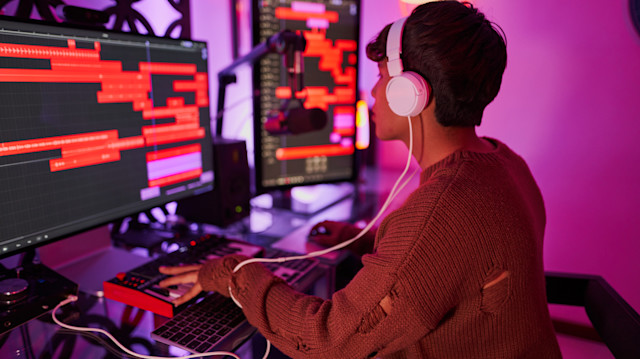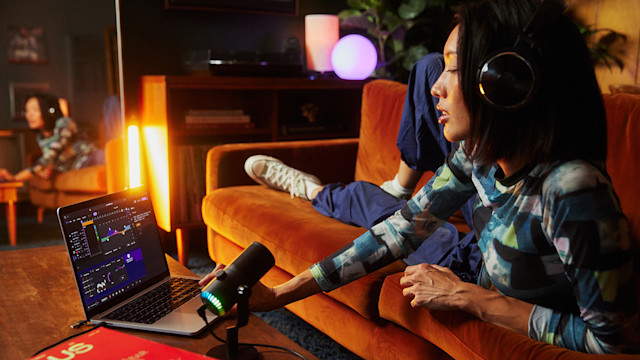Building a Home Studio on a Budget
September 10, 2024 - Looking for ways to build your studio without breaking the bank? This guide breaks down some easy and affordable solutions.

So you’ve got some song ideas and you’re ready for them to come to life!
Studio time is expensive, and building a home studio is expensive and time consuming. Or is it? Since recording music started to become democratized through tape machines and early DAW software, musicians have been creating in sub-optimal spaces. It’s about working with what you have, thinking smart, and getting creative. In this guide, I’ll break down some of the best ways to create a versatile home studio on a limited budget.
The Room
Often the most neglected part of any home studio, but arguably one of the most important. There is a tendency to prioritize purchasing the right speakers, headphones or software, but if you’re making music in a room which is not acoustically treated you won’t be able to accurately hear what you’re making.
The Space
As a rule, square rooms are terrible to mix and hear music in. Because they are so uniform in size, sound waves disperse in a similarly uniform way. This can lead to a build up of bass frequencies, standing waves (sound waves that interfere with each other), and phase issues. The best kind of space to work in would be a loft room or a room with unique angles, or more ideally- 4 walls that aren’t parallel to each other. Wall materials can also be an influencing factor, but most of these issues can be fixed with adequate acoustic treatment.
Absorbers
If you’re fortunate enough to have a choice of which room to use for your studio, it’s best to aim for a room which has plenty of naturally occurring absorption. Carpeted rooms are much better suited than rooms with hardwood floors, though if you don’t have carpeted rooms, find some second hand or cheap rugs and cover as much of the floor as possible with them. Duvets, pillows, and other soft furnishings can all contribute to overall absorption of your studio too.
If you’ve ever seen pictures of a professional studio, it’s common to have a couch behind the mixing desk where the engineer sits. This serves the dual purpose of comfort and sound absorption. If you have the space, a (preferably clean) second hand couch placed behind where you sit could massively impact how you hear your music.
Another great budget solution (especially when recording vocals or voice overs) is to create a DIY vocal booth using a duvet. Simply hang your duvet or blanket over a structure in your room that gives you enough space to work, but also encases you entirely. This way sound will hit the soft, absorbing material of the fabric and you’ll get a result which is close to dead, and therefore able to be processed with ease. If you can make it big enough, this can also work with any live instrument, even drums if your room is big enough!
Diffusers
Absorbers are great if you’re planning on doing plenty of live recording with microphones in your home studio because they create a ‘dead’ sound with no unnatural reverb. You can then add your own reverb at your pleasure. However having a totally dead room to mix and listen to your music in can create an unnatural sound. How often do you listen to music in a room which is totally acoustically dead?
A big part of mixing and creating music is being able to understand how your music will translate to people listening in everyday environments that are terrible acoustically. Diffusers take sound waves and disperse them throughout a room, which gives a more ‘live’ feel to your studio. The best budget diffusion solution is to use tightly compacted books on a bookshelf. If you look at many diffusers, they are bumpy, almost textured surfaces, and bear some resemblance to books on bookshelves.
Software
Room ready? Perfect, let’s get into the nitty gritty!
When you’re working on a budget, the software you use is often a hidden expense that increases exponentially if you’re working with something not built for purpose. You have to consider several factors when deciding on what software to use.
Accessibility
How easy is the software to use? You need something which is intuitive and has a great UI which makes creativity easy. You don’t want to be researching how to turn on input monitoring for a track when an idea is bouncing around in your head
Built in features
This one is massive. If you end up getting high end software used for tracking live instrumentation, it’s likely there will be minimal features or plugins that come with the software. You need something that has plenty of built in features, plugins and effects at the lowest possible cost.
Requirements on hardware
You could spend plenty of money on a great DAW, or buy plenty of plugins. But what happens if you have a laptop which can’t deal with the burden of complicated software? Nothing happens- your computer won’t be able to load quick enough, and creativity will be hampered.
Collaborativity
Often overlooked with traditional software, but this is a key feature in the musical landscape today. Collaborations often happen thousands of miles apart, and exporting & delivering hefty DAW sessions with a smorgasbord of different plugins can be difficult and time consuming.
Platforms like Soundtrap take into consideration these factors, and make it easy for creativity to flourish through accessibility. As an online DAW, the requirements on hardware aren’t as intense as some other DAWs. In terms of budget, Soundtrap also has a free tier with a vast amount of built-in features, as well as a gentler learning curve, facilitated by a user-friendly interface.

Hardware
A contentious topic, discerning what you need is often the biggest challenge with hardware. It’s also the most costly part of studio building, as well as the most talked about. When you’re thinking about what gear you need, it’s imperative to keep a level head and not get caught up in the whirlwind of online forums telling you to drop $5000 on life changing guitar picks. Ever heard of the term “all the gear, no idea”? It’s a well known phenomenon amongst audio engineers and musicians with cash to splash, and it’s something you should avoid. Here’s a breakdown of the most essential hardware which will get you up and running quickly and cheaply:
Microphone: If you’re in a home studio, you’ll want a dynamic microphone. They are less sensitive than condenser microphones and have a tendency to pick up less background noise. However, Soundtrap has an option to use your computer mic if a microphone is not a priority for you yet.
Audio Interface: An audio interface bridges the gap between your microphone and your computer by converting the audio signal from your microphone into digital audio you can play on your computer. If it’s just you, you’ll only need something with one or two inputs.
Headphones: Open back headphones are better for critical listening and for mixing, and they are more comfortable to wear over long periods of time.
Cables: One XLR cable (microphones), and one ¼ inch jack cable (other instruments). That’s all you’ll need with a budget interface. If you have any other instruments or midi controllers, they will come with their own cables that allow you to connect to your computer.
Speakers: If you’re buying a pair of speakers on a budget, you need to buy active speakers. They are speakers with a built-in amplifier. Passive speakers require a separate amplifier which can end up costing more money. You will need additional cables for speakers.
Mic stand: Mic stands are really cheap, and often come bundled with new microphones and microphone starter kits. If you’re really on a budget though, you can easily make a mic stand out of a coat hanger which rests on your desk. It’s a dirty solution, but sometimes the best solutions are!
Ideally, these are the essentials. Depending on what music you create, some of these will be less essential than others. I’d always recommend looking at reputable second hand websites for budget music gear, and if you can, try not to throw away your equipment until you’ve had it for a long time without using it. Too many times I’ve thrown away or sold a great piece of equipment that I thought I wouldn’t use anymore, only to need it on a track 2 months later. Build your hardware collection slowly, and with intention.
Vibe
Over the course of my life, I have been in many different iterations of the home studio. Many of them are great environments where creativity and inspiration can develop with ease. Others are foul dungeons, littered with empty takeout boxes and abandoned dreams. Get the vibe right! You will be spending a crazy amount of time in your studio, tweaking, editing, creating. You have to make it a pleasant place to be, otherwise you’re going to associate your creative practice with awful smells and endless mess.
Storage
This is huge. If you don’t know where anything is, good luck trying to find it. In the early days I would be rummaging through boxes looking for XLR cables and jack leads, sometimes forgetting my idea by the time I’d found what I was looking for. If you’re saving on space or in rented accommodation and need somewhere to store cables- use the side of your desk if you can. Glueing hooks onto the side of (or underneath) your desk will give you a place to put headphones, cables and more. Proper storage will really make your studio feel intentional and professional, and it's a vastly overlooked part of studio building.
Lighting
If you’re working in a studio with a single main light on all the time, I would recommend you seek professional help. Dim lighting is easier on your eyes over long periods, and it contributes positively to the overall mood of your space. Humans have been making music for thousands of years, often around dimly lit campfires, not under offensively bright lights you’d find in a fast food place. Embrace the tribal spirit of your ancestors and buy a lava lamp.
Artwork
Being creative is absorbing the world around you and translating it into something others can enjoy. In one of my old home studios I had a wall just filled with loads of random things I had accumulated over the years. These included pictures with friends, stickers, postcards and other bits and pieces. I would look over to the wall sometimes and get inspiration for songs from it, and it made the studio feel like my space, and therefore a safe space to be creative and let loose. Put your own stamp on your space if you can.
Conclusion
It’s a common misconception that building a home studio will break the bank, ruin your credit score and lead to bad results that aren’t worth the time or money. Hopefully in this guide those misconceptions have been squashed, and you’re ready to get started with some creative ideas to get the most out of your home studio!
About the author
Max McLellan is a composer, songwriter, and audio engineer with credits ranging across film, TV and radio. He provides composition, mixing, and mastering services through his company MKM Audio.
Get started with Soundtrap today!